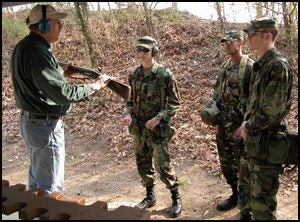ECU Army ROTC cadets get lesson in historical weapons
Larry Babits, ECU professor of maritime history and a battlefield archaeologist, instructs ECU Army ROTC cadets (from left) Tom Barsalou, Theodore Bush and John Miller on the Continental Army flintlock musket from the Revolutionary War. Photo by Nancy McGillicuddy
Weapons dating to the 1500s taught East Carolina University Army ROTC cadets last month Army history and old-fashioned stance.

Larry Babits, ECU professor of maritime history and a battlefield archaeologist, instructs ECU Army ROTC cadets (from left) Tom Barsalou, Theodore Bush and John Miller on the Continental Army flintlock musket from the Revolutionary War. Photo by Nancy McG
About 40 cadets took part in a class on historical weapons of the American Infantry at the Pitt County Wildlife Club.
Mainly juniors and seniors comprised the class, which aimed to show history and the connection between vintage and modern warfare.
“The purpose is for the cadets to have a better understanding of the history of the infantryman and where some of the practices that we still use today come from,” said Larry Babits, ECU professor of maritime history and a battlefield archaeologist.
In addition to a static display of weapons dating from 1550 to 2001, cadets fired four types of weapons that were used between 1690 and 1970: A Continental Army flintlock musket from the Revolutionary War; a World War II era M-1 Garand rifle; a 1768 Charleville musket, which was a Continental Army standard issue weapon; and the 1903 Springfield, a standard issue weapon in World War I also used as a sniper rifle in World War II and the Korean War.
“The more primitive weapons teach what soldiers are supposed to do with the modern weapon,” said Babits, who taught cadets to use the flintlock musket.
The historic weapons — heavier and more ungainly than modern rifles — produce a pronounced recoil, or kick, that requires soldiers to hone sight picture, stance and precision skills.
“If you can shoot one of these weapons well then you can shoot a modern one very well,” said Babits, holding a 200-year old musket in his gun-powder black stained hands. “It requires a lot more mental discipline to shoot these and hit because the modern weapons are so much more sophisticated.”
Known for their inaccuracy, flintlocks fire when a flint and hammer produce a spark. Out of 20 flintlock shots fired on the early spring afternoon, the cadets hit the target 80 percent of the time.
“Eighty percent is pretty good for 40 yards and no experience,” said Babits, whose research includes battlefield lethality of weapons.
“That kind of shooting tells me that 30-40 yards is a good range for the weapons.”
Eight instructors showed the cadets how to load the antique ammo.
The class also aimed to reinforce the notion that dated weapons are also deadly weapons.
“Just because they are old does not mean they are not lethal,” Babits said.
Old age does not mandate a worldwide retirement for these weapons either. Enemy troops and insurgents in the Middle East frequently utilize rifles similar to those on display for the cadets. Troops’ knowledge of enemy firearms is an advantage.
“If one of our troops has a malfunction or runs out of ammunition, he or she can still continue the engagement with opposition weaponry if they know how to use it,” Babits said.
The oldest weapon on display was a crossbow from 1585. The weapons are from personal collections in the Pitt County area.
“This is a military timeline in the form of weapons,” said Maj. Dan Heape, an assistant professor Military Science at ECU. “The cadets have not fired these weapons before so they are out there having fun.”
About 30 weapons rested on tables while John Wallace, a former Marine officer and retired FBI agent, conveyed their history. Cadets browsed the aisle of engagement history and asked questions about their use.
“This is a way to keep history alive,” Babits said.